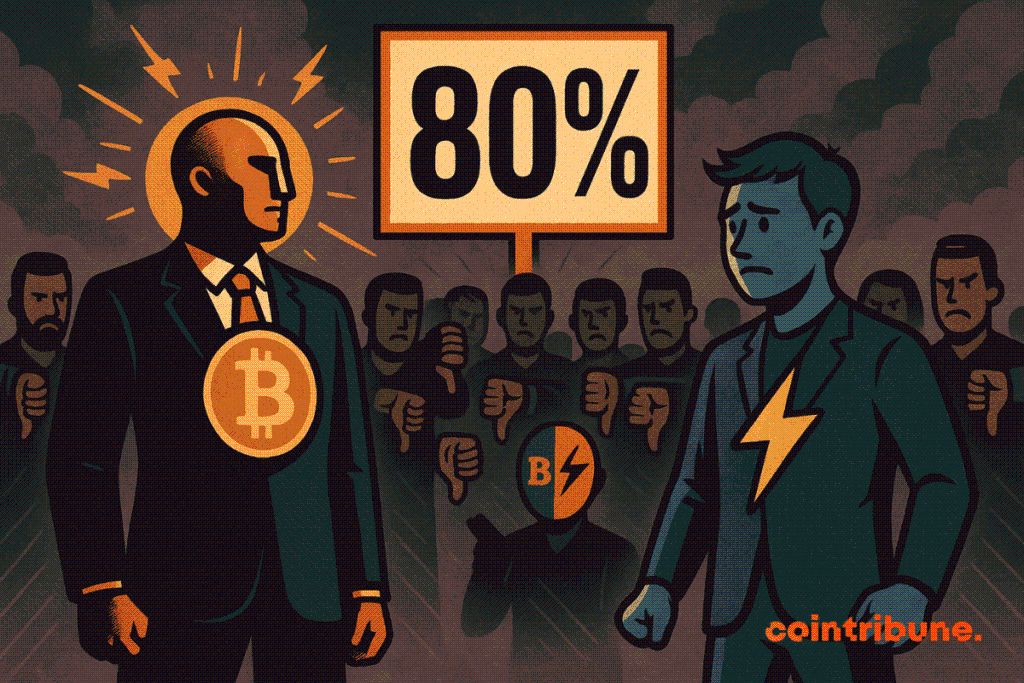Is the Lightning Network Losing Steam? The Numbers Raise Questions
An online survey sparked controversy: more than 80% of respondents believe that Lightning is not “real bitcoin.” A massive figure, and a clear divide between technical promise and market perception. The debate exploded on X, opposing pro-Lightning figures and sharp critics. Let’s summarize, decode, and project.

In brief
- A survey shows that 80% of respondents do not consider Lightning as real bitcoin
- The debate opposes critics mentioning complexity and liquidity dependence to defenders highlighting real use and micropayments
- Metrics stagnate while custodial products gain ground, hence the priority for a better UX and improvements like splicing.
Shocking survey, disrupted narrative
The message is harsh, for a large majority, Lightning does not embody “native” bitcoin. This perception is based on a simple intuition: if one must go on-chain to enter and exit the network, then Lightning appears as a separate environment, almost like a distinct token. The technical nuance, however, was not enough to convince.
In this context, the critics drove the point home. Paul Sztorc talks about a “cool system at first” that, over the years, “does not work.” He points out concrete constraints: nodes connected permanently, dependence on liquidity providers, need for watchtowers. For him, the user experience quickly slides toward custodial, and trust erodes.
On the other side, the response is clear. Alex Gladstein defends Lightning as a digital cash in bitcoin, without banks.
Matt Corallo adds a volume point: a double-digit share of BTC transactions would today be routed via Lightning. For them, the real-world reality already exists. The denial would, precisely, be to deny these uses.
The numbers that upset: stagnation and perceived centralization
Let’s look at the public metrics. The Lightning capacity is around a few thousand BTC , roughly the same level as in September 2022. No real surge in three years. The signal is clear: traction has not materialized at the hoped-for pace.
Another indicator, even tougher: the number of payment channels has almost halved since 2022, falling from over 80,000 to about 45,000. This is a marker of network density, surface, liquidity, and resilience. When channels diminish, the perception of centralization mechanically increases. And the “everyone can route everything” discourse loses credibility.
However, Lightning retains a key advantage: costs. Tiny payments, routed off-chain, sometimes approach a fraction of a cent. By contrast, on-chain bitcoin fees can devour hundreds of basis points on small amounts. On the “micropayments” axis, the technical advantage persists. But the narrative advantage, it wavers.
Competition from Bitcoin ETFs and revival avenues
Staying on the subject of perception, the context does not help. Volumes are exploding elsewhere, via ETFs. In Q3, JPMorgan observes a renewed interest in spot bitcoin ETFs , while wBTC-like and cbBTC progress. Apps like Moonshot, Base or Fomo boast onboarding in a few clicks, fast transactions, a smooth UX. The general public follows the slightest friction. And the bitcoin ecosystem pays for every step that seems too technical.
Should we bury Lightning? No. But we must tell the truth. The network has not converted the post-2022 trial. It remains powerful for specific cases: low-value recurring payments, “pay-per-use” models, targeted remittances. To scale, it lacks a “default” experience that hides the complexity of channels, liquidity, penalties, and connections. For market context, bitcoin trades today around the 106,000 $ mark at the time of writing, a symbolic milestone illustrating a moving ecosystem.
Disclaimer: The content of this article solely reflects the author's opinion and does not represent the platform in any capacity. This article is not intended to serve as a reference for making investment decisions.
You may also like
Fed Split: Should They Prioritize Fighting Inflation or Supporting Employment?
- Fed policymakers remain divided over prioritizing inflation control or labor-market support, with hawks like Bostic urging rate stability until inflation nears 2%. - Dovish officials argue slowing job growth (29,000 monthly payrolls in late 2024) demands rate cuts to sustain economic momentum despite inflation risks. - Tariff adjustments and delayed economic data complicate decisions, with Treasury's import relief measures facing criticism for potential inflationary rebound. - Looming student loan tax ch

YFI has dropped 7.68% over the past week during a period of heightened volatility and ongoing downward momentum
- YFI fell 7.68% weekly to $4747, reflecting ongoing bearish sentiment amid broader market weakness. - Technical indicators show bearish alignment (EMA/SMA below price) and key support at $4500–$4600 as critical near-term levels. - Historical backtesting reveals limited post-crash recovery potential, with buy-and-hold win rates between 48-62% after 10%+ drops. - YFI remains vulnerable to further declines without a significant shift in market dynamics or bullish catalysts.
Polkadot News Today: "Why Presale Investors Prefer BlockchainFX's AOFA License Instead of Polkadot or Polygon"
- BlockchainFX secures AOFA license, boosting investor confidence and attracting whale capital amid market shifts toward early-stage projects. - Its $11M+ presale offers tokens at $0.03 with a 50% bonus code, contrasting with slower growth curves of Polkadot and Polygon due to larger market caps. - The project's hybrid model combines regulatory credibility, utility-driven beta platform, and staking rewards, positioning it as a "super app" for multi-asset trading. - Aggressive ROI projections and $500K Glea

BCH Stock - 0.70% Potential Gain as Governance Improves
- BCH fell 0.02% in 24 hours and 5.51% monthly, with Goldman Sachs maintaining a Neutral rating and 0.70% upside target. - Institutional holdings showed mixed activity, including a 289.93% stake reduction by Baillie Gifford, while governance reforms aimed to enhance transparency. - Projected 19.4% revenue growth and $8.49 non-GAAP EPS signal modest recovery, though weak loan growth and bearish put/call ratio (4.11) highlight risks.
